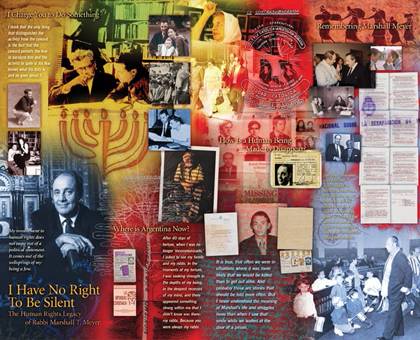
"I have no right
to be silent in the face of injustice!" Rabbi Marshall T. Meyer said in a 1991
sermon. "I cannot dare to hide in my garden when people scream in pain!
Nor can you, whether you are conservative or liberal, rightist or leftist or centrist....
That's one of the reasons to be an activist."
An ordinary American
whose extraordinary convictions, faith, and impetuous personality impelled him
to become a leading human rights activist during Argentina's Dirty War
(1976-1983), Meyer left not only a legacy of faith and teachings to his
students and congregations but also a compelling model of how a person of faith
can embrace activism as a central part of their religious life. He died in
1993.
That legacy is on
display in a new exhibit that opens at Duke on Oct. 3. Based on materials culled
from Meyer's personal papers housed in Duke's Special Collections Library, the
exhibit consists of 12 banners, each approximately 3 feet wide by 6 feet tall.
The design incorporates materials culled from the Meyer archives, including
intimate family photos, moving letters from prisoners, original art work
internal government memos and rare human rights publications.
The text was prepared
by Katharine French Fuller, a Duke graduate student in history, under the
supervision of Patrick Stawski, Duke's human rights archivist. The design was
executed by Pam Chastain and James Jarvis of Pam Chastain Design.
Along with faith
leaders such as the Rev. Martin Luther King Jr. and Rabbi Abraham Joshua
Heschel, Meyer was an early human rights leader who has inspired many students
and fellow activists.
"Whenever I
speak to faith communities about human rights and their place in faith traditions,
these are my three modern touchstones," said Robin Kirk, program director
of the Duke Human Rights Center.
The exhibit has been
on display at the Organization of American States in Washington, DC, as well as
B'nai Jeshurun and the Jewish Theological Seminary, both in New York City and
places where Meyer studied or worked. The purpose, Kirk said, is not only to
inspire an admiration of Meyer's work but also to promote community dialogue
about faith, activism and human rights.
"The Marshall
Meyer papers are a perfect candidate for a traveling exhibit. Not only is
Marshall's work and legacy incredibly compelling but we were also fortunate
enough that he left behind a rich documentary legacy which his family had the
foresight to preserve in partnership with Duke University Libraries," said
Stawski.
The exhibit opens on
Oct. 3 with a 5:30 p.m. ceremony at the Goodson Chapel at the Duke Divinity
School. The ceremony will include comments by Meyer's son and social activist Gabriel
Meyer, as well as a performance of sacred Ladino music by the Jewish Chorale of
the Triangle. Among the singers is Meyer's nephew, Eric Meyers, Bernice & Morton Lerner Professor of Center for Jewish
Studies and Religion at Duke and the director of the Center for Jewish Studies. A reception will follow outside the
Goodson Chapel.
The exhibit is funded
by the generosity of an anonymous donor and is a co-project of the Duke Human
Rights Archive at Duke University Libraries, The Duke Human Rights Center and
the Duke Center for Jewish Studies.
The exhibit will be
on display in the Divinity
School's York Room through Dec. 18. An on-line version of
the exhibit is available
here.
For more information
on the exhibit, visit: http://library.duke.edu/specialcollections/human-rights/
.